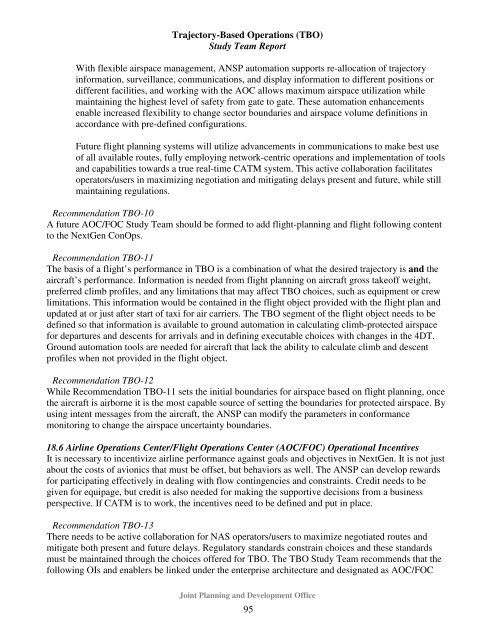Trajectory-Based Operations (TBO) - Joint Planning and ...
Trajectory-Based Operations (TBO) - Joint Planning and ...
Trajectory-Based Operations (TBO) - Joint Planning and ...
You also want an ePaper? Increase the reach of your titles
YUMPU automatically turns print PDFs into web optimized ePapers that Google loves.
<strong>Trajectory</strong>-<strong>Based</strong> <strong>Operations</strong> (<strong>TBO</strong>)<br />
Study Team Report<br />
With flexible airspace management, ANSP automation supports re-allocation of trajectory<br />
information, surveillance, communications, <strong>and</strong> display information to different positions or<br />
different facilities, <strong>and</strong> working with the AOC allows maximum airspace utilization while<br />
maintaining the highest level of safety from gate to gate. These automation enhancements<br />
enable increased flexibility to change sector boundaries <strong>and</strong> airspace volume definitions in<br />
accordance with pre-defined configurations.<br />
Future flight planning systems will utilize advancements in communications to make best use<br />
of all available routes, fully employing network-centric operations <strong>and</strong> implementation of tools<br />
<strong>and</strong> capabilities towards a true real-time CATM system. This active collaboration facilitates<br />
operators/users in maximizing negotiation <strong>and</strong> mitigating delays present <strong>and</strong> future, while still<br />
maintaining regulations.<br />
Recommendation <strong>TBO</strong>-10<br />
A future AOC/FOC Study Team should be formed to add flight-planning <strong>and</strong> flight following content<br />
to the NextGen ConOps.<br />
Recommendation <strong>TBO</strong>-11<br />
The basis of a flight’s performance in <strong>TBO</strong> is a combination of what the desired trajectory is <strong>and</strong> the<br />
aircraft’s performance. Information is needed from flight planning on aircraft gross takeoff weight,<br />
preferred climb profiles, <strong>and</strong> any limitations that may affect <strong>TBO</strong> choices, such as equipment or crew<br />
limitations. This information would be contained in the flight object provided with the flight plan <strong>and</strong><br />
updated at or just after start of taxi for air carriers. The <strong>TBO</strong> segment of the flight object needs to be<br />
defined so that information is available to ground automation in calculating climb-protected airspace<br />
for departures <strong>and</strong> descents for arrivals <strong>and</strong> in defining executable choices with changes in the 4DT.<br />
Ground automation tools are needed for aircraft that lack the ability to calculate climb <strong>and</strong> descent<br />
profiles when not provided in the flight object.<br />
Recommendation <strong>TBO</strong>-12<br />
While Recommendation <strong>TBO</strong>-11 sets the initial boundaries for airspace based on flight planning, once<br />
the aircraft is airborne it is the most capable source of setting the boundaries for protected airspace. By<br />
using intent messages from the aircraft, the ANSP can modify the parameters in conformance<br />
monitoring to change the airspace uncertainty boundaries.<br />
18.6 Airline <strong>Operations</strong> Center/Flight <strong>Operations</strong> Center (AOC/FOC) Operational Incentives<br />
It is necessary to incentivize airline performance against goals <strong>and</strong> objectives in NextGen. It is not just<br />
about the costs of avionics that must be offset, but behaviors as well. The ANSP can develop rewards<br />
for participating effectively in dealing with flow contingencies <strong>and</strong> constraints. Credit needs to be<br />
given for equipage, but credit is also needed for making the supportive decisions from a business<br />
perspective. If CATM is to work, the incentives need to be defined <strong>and</strong> put in place.<br />
Recommendation <strong>TBO</strong>-13<br />
There needs to be active collaboration for NAS operators/users to maximize negotiated routes <strong>and</strong><br />
mitigate both present <strong>and</strong> future delays. Regulatory st<strong>and</strong>ards constrain choices <strong>and</strong> these st<strong>and</strong>ards<br />
must be maintained through the choices offered for <strong>TBO</strong>. The <strong>TBO</strong> Study Team recommends that the<br />
following OIs <strong>and</strong> enablers be linked under the enterprise architecture <strong>and</strong> designated as AOC/FOC<br />
<strong>Joint</strong> <strong>Planning</strong> <strong>and</strong> Development Office<br />
95
















